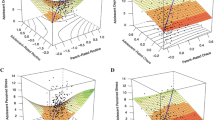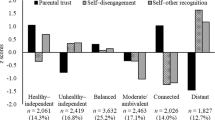Abstract
Questionnaire data from 376 undergraduates (mean age=19.3 years) were used to test a model describing interrelationships among deidealization, relatedness, autonomy, and insecurity in late adolescents' relationships with their parents. As expected, deidealization predicted greater autonomy and less relatedness (i.e., more disengagement), greater disengagement predicted greater insecurity, and greater insecurity predicted less autonomy. However, disengagement from parents proved to be a “double-edged sword” in that it was linked not only to insecurity, but also to feelings of greater separateness and self-directedness in relation, to parents. Additional analyses identified significant associations between the adolescent/parent relationship variables and the adolescents' psychological health and ego identity status.
Similar content being viewed by others
References
Adams, G. R., Shea, J., and Fitch, S. A. (1979). Toward the development of an objective assessment of ego identity status.J. Youth Adolesc. 8: 223–237.
Ainsworth, M., and Ainsworth, L. (1958).Measuring Security and Personal Adjustment, University of Toronto Press, Toronto.
Armsden, G., and Greenberg, M. (1987). The Inventory of Parent and Peer Attachment: Individual differences and their relationship to psychological well-being in adolescence.J. Youth Adolesc. 16: 427–454.
Blos, P. (1967). The second individuation process of adolescence.Psychoanal. Study Child 22: 162–196.
Campbell, E., Adams, G. R., and Dobson, W. R. (1984). Familial correlates of identity formation in late adolescence: A study of the predictive utility or connectedness and individuality in family relations.J. Youth Adolesc. 13: 509–525.
Constantinople, A. (1969). An Eriksonian measure of personality development among college students.Dev. Psychol. 1: 357–372.
Cote, J. E., and Levine, C. (1988). A critical examination of the ego identity status paradigm.Dev. Rev. 8: 147–184.
Craig-Bray, L., and Adams, G. R. (1986). Different methodologies in the assessment of identity: Congruence between self-report and interview techniques.J. Youth Adolesc. 15: 191–204.
Douvan, F., and Adelson, J. (1966).The Adolescent Experience, Wiley, New York.
Epperson, D. C. (1964). A reassessment of indices of parental influence in “the adolescent society.”Am. Sociol. Rev. 29: 93–96.
Frank, S., and Tuer, M. (1988). Family predictors of adolescent adjustment. Paper presented at the Annual Convention of the American Psychological Association, New Orleans.
Frank, S., Avery, C., and Laman, M. (1988). Young adults' perceptions of their relationships with their parents: Individual differences in connectedness, competence, and emotional autonomy.Dev. Psychol. 24: 729–737.
Frank, S., DeVet, C., Burke, L., and Tatham, L. (1990). Implications of parental marital status and conflict for late adolescent/parent relationships and adolescent adjustment (in progress).
Grotevant, H. D., and Adams, G. R. (1984). Development of an objective measure to assess ego-identity in adolescence: Validation and replication.J. Youth Adolesc. 13: 419–438.
Grotevant, H. D., and Cooper, C. R. (1986). Individuation in family relationships: A perspective on individual differences in the development of identity and role-taking skill in adolescence.Hum. Dev. 29: 82–100.
Hill, J. P., and Holmbeck, G. N. (1986). Attachment and autonomy during adolescence.Ann. Child Dev. 3: 145–189.
Jordan, D. (1971).Parental Antecedents and Personality Characteristics of Ego Identity Statuses, Unpublished doctoral dissertation, SUNY at Buffalo, Buffalo, NY.
Josselson, R. L. (1980). Ego development in adolescence. In Adelson, J. (ed.),Handbook of Adolescent Psychology, Wiley, New York, pp. 188–210.
Kandel, D., and Lesser, G. S. (1972).Youth in Two Worlds, Jossey-Bass, San Francisco.
Koenig, L., Howard, K. I., Offer, D., and Cremerius, M. (1984). Psychopathology and adolescent self-image. In Offer, D., Ostrov, E., and Howard, K. I. (eds.).Patterns of Adolescent Self-image: New Directions for Mental Health Services, Jossey-Bass, San Francisco, No. 22, pp. 57–71.
Murphey, E. B., Silber, E., Coehlo, G. V., Hamburg, D. A., and Greenberg, I. (1963). Development of autonomy and parent-child interaction in late adolescence.Am. J. Orthopsychiat. 33: 643–652.
Newman, B. M., and Newman, P. R. (1975).Development Through Life: A Psychosocial Approach, Dorsey Press, Homewood, Ill.
Offer, D., and Offer, J. (1975).From Teenage to Young Manhood, Basic, New York.
Offer, D., Ostrov, E., and Howard, K. (1989).The Offer Self-image Questionnaire for Adolescents, Michael Reese Hospital, Chicago.
Ostrov, E., Offer, D., and Hartlage, S. (1984). The quietly disturbed adolescent. In Offer, D., Ostrov, E., and Howard, K. I. (eds.),Patterns of Adolescent Self-image: New Directions for Mental Health Services, Jossey-Bass, San Francisco, No. 22, pp. 73–81.
Rutter, M., Graham, P., Chadwick, O., and Yule, W. (1976). Adolescent turmoil: Fact or fiction?J. Child Psychol. Psychiat. 17: 35–56.
Ryan, R. M., and Lynch, J. H. (1989). Emotional autonomy versus detachment: Revisiting the vicissitudes of adolescence and young adulthood.Child Dev. 60: 340–356.
Silverberg, S. B., and Steinberg, L. (1987). Adolescent autonomy, parent-adolescent conflict, and parental well-being.J. Youth Adolesc. 16: 293–312.
Steinberg, L. (1988). Reciprocal relations between parent-child distance and pubertal maturation.Dev. Psychol. 24: 122–128.
Steinberg, L., and Silverberg, S. (1986). The vicissitudes of autonomy in early adolescence.Child Dev. 57: 841–851.
Stutman, S., and Lich, S. (1984).The Development and Utilization of the Parental Relationship Inventory, Los Angeles.
Waterman, A. S. (1988). Identity status theory and Erikson's theory: Communalities and differences.Dev. Rev. 8: 185–208.
Weiss, R. S. (1982). Attachment in adult life. In Parke, C., and Stevenson-Hinde, J. (eds.),The Place of Attachment in Human Behavior, Basic Books, New York, pp. 171–184.
White, K. M., Speisman, J. C., and Costos, D. (1983). Young adults and their parents: Individuation to mutuality. In Grotevant, H. D., and Cooper, C. R. (eds.),Adolescent Development in the Family: New Directions for Child Development, Jossey-Bass, San Francisco, No. 22, pp. 61–76.
Wright, V., Frank, S., and Pirsch, L. (1990). Mediators in the relationship between parent alcoholism and late adolescent separation/individuation pathology. Paper presented at the Biannual Conference of the Society for Research on Adolescence, Atlanta, Ga.
Youniss, J., and Smollar, J. (1985).Adolescent Relations with Mothers, Fathers, and Friends, University of Chicago Press, Chicago.
Author information
Authors and Affiliations
Additional information
Received her Ph.D. from Yale University. Major interests are in parent/child relationships during late adolescence and young adulthood.
Received her B.A. from University of Virginia and M.A. from Michigan State University. Major interests are in adolescent development and pediatric psychology.
Received her B.A. from Duke University and M.A. from Michigan State University. Major interests are in adult children of alcoholics and adolescent separation/individuation.
Rights and permissions
About this article
Cite this article
Frank, S.J., Pirsch, L.A. & Wright, V.C. Late adolescents' perceptions of their relationships with their parents: Relationships among deidealization, autonomy, relatedness, and insecurity and implications for adolescent adjustment and ego identity status. J Youth Adolescence 19, 571–588 (1990). https://doi.org/10.1007/BF01537177
Received:
Accepted:
Issue Date:
DOI: https://doi.org/10.1007/BF01537177




